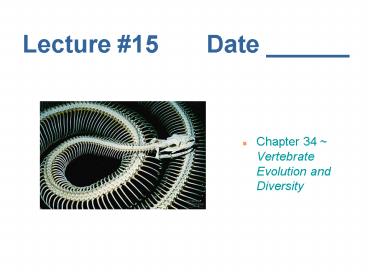Lecture - PowerPoint PPT Presentation
1 / 15
Title:
Lecture
Description:
Notochord: longitudinal, flexible rod located between the ... Monotremes (egg-laying): platypus; echidna. Marsupials (pouch): opossums, kangaroos, koalas ... – PowerPoint PPT presentation
Number of Views:147
Avg rating:3.0/5.0
Title: Lecture
1
Lecture 15 Date ______
- Chapter 34 Vertebrate Evolution and Diversity
2
Chordates
- Notochord longitudinal, flexible rod located
between the digestive and the nerve cord - Dorsal, hollow nerve cord eventually develops
into the brain and spinal cord - Pharyngeal slits become modified for gas
exchange, jaw support, and/or hearing - Muscular, postanal tail
3
Invertebrate chordates
- Both suspension feeders..
- Subphy Urochordata (tunicates sea squirt)
mostly sessile marine - Subphy Cephalochordata (lancelets) marine, sand
dwellers - Importance vertebrates closest relatives in
the fossil record, appear 50 million years before
first vertebrate - Paedogenesis precocious development of sexual
maturity in a larva (link with vertebrates?)
4
Subphylum Vertebrata
- Retain chordate characteristics with
specializations. - Neural crest group of embryonic cells near
dorsal margins of closing neural tube - Pronounced cephalization concentration of
sensory and neural equipment in the head - Cranium and vertebral column
- Closed circulatory system with a ventral
chambered heart
5
Vertebrate diversity
- Phy Chordata
- Subphy Vertebrata
- Superclass Agnatha jawless
vertebrates (hagfish, lampreys) - Superclass Gnathostomata jawed vertebrates
with 2 sets of paired appendages including
tetrapods (4-footed) and amniotes (shelled
egg)
6
Superclass Agnatha
- Jawless vertebrates
- Most primitive, living vertebrates
- Ostracoderms (extinct) lamprey and hagfish
(extant) - Lack paired appendages cartilaginous skeleton
notochord throughout life rasping mouth
7
Superclass Gnathostomata, I
- Placoderms (extinct) first with hinged jaws and
paired appendages - Class Chondrichthyes Sharks, skates, rays
- Cartilaginous fishes well developed jaws and
paired fins continual water flow over gills (gas
exchange) lateral line system (water pressure
changes) - Life cycles
- Oviparous- eggs hatch outside mothers body
- Ovoviviparous- retain fertilized eggs nourished
by egg yolk young born live - Viviparous- young develop within uterus
nourished by placenta
8
Superclass Gnathostomata, II
- Class Osteichthyes
- Ossified (bony) endoskeleton scales
operculum(gill covering) swim bladder (buoyancy) - Most numerous vertebrate
- Ray-fined (fins supported by long, flexible
rays) bass, trout, perch, tuna, herring - Lobe-finned (fins supported by body skeleton
extensions) coelocanth - Lungfishes (gills and lungs) Australian
lungfish (aestivation)
9
Superclass Gnathostomata, III
- Class Amphibia
- 1st tetrapods on land
- Frogs, toads, salamanders, caecilians
- Metamorphosis lack shelled egg moist skin
for gas exchange
10
Superclass Gnathostomata, IV
- Class Reptilia
- Lizards, snakes, turtles, and crocodilians
- Amniote (shelled) egg with extraembryonic
membranes (gas exchange, waste storage, nutrient
transfer) absence of feathers, hair, and mammary
glands ectothermic scales with protein keratin
(waterproof) lungs ectothermic (dinosaurs
endothermic?)
11
Superclass Gnathostomata, V
- Class Aves
- Birds
- Flight adaptations wings (honeycombed bone)
feathers (keratin) toothless one ovary - Evolved from reptiles (amniote egg and leg
scales) endothermic (4-chambered heart) - Archaeopteryx (stemmed from an ancestor that gave
rise to birds)
12
Superclass Gnathostomata, VI
- Class Mammalia
- Mammary glands hair (keratin) endothermic
4-chambered heart large brains teeth
differentiation - Evolved from reptilian stock before birds
- Monotremes (egg-laying) platypus echidna
- Marsupials (pouch) opossums, kangaroos, koalas
- Eutherian (placenta) all other mammals
13
Order Primates (evolution)
- Characteristics hands feet for grasping
large brains, short jaws, flat face parental
care and complex social behaviors - Suborder Prosimii lemurs, tarsiers
- Suborder Anthropoidea monkeys, apes, humans
(opposable thumb) - 45-50 million years ago
- Paleoanthropology study of human origins
- Hominoid great apes humans
- Hominid (narrower classification) v
australopithecines (all extinct) v genus Homo
(only 1 exant, sapiens)
14
Human evolution
- Misconceptions
- 1- Chimp ancestor (2 divergent branches)
- 2- Step-wise series (coexistence of human
species) - 3- Trait unison vs. mosaic evolution (bipedalism,
upright, enlarged brain)
15
The first humans
- Ape-human split (5-7 mya)
- Australopithecus Lucy (4.0 mya)
- Homo habilis Handy Man (2.5 mya)
- Homo erectus first to migrate (1.8 mya)
- Neanderthals (200,000 ya)
- Homo sapiens (1.0 mya?)
- Multiregional model (parallel evolution)
- Out of Africa (replacement evolution)































